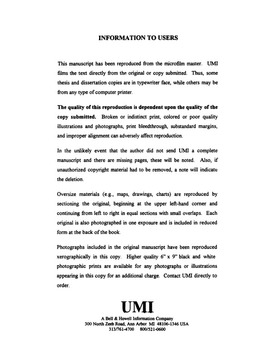| dc.contributor.advisor | O'Hair, Mary John, | en_US |
| dc.contributor.author | Dzialo, Linda Giles. | en_US |
| dc.date.accessioned | 2013-08-16T12:30:41Z | |
| dc.date.available | 2013-08-16T12:30:41Z | |
| dc.date.issued | 1999 | en_US |
| dc.identifier.uri | https://hdl.handle.net/11244/5847 | |
| dc.description.abstract | The researcher mailed a survey to 155 Oklahoma middle school principals, 188 middle school counselors and 160 middle school teachers. Largely a rural state, Oklahoma has a wide range of school district size, school size as well as grade configurations used to define a middle school. Data indicated that more than 89% of Oklahoma's middle school educators report that their school had a sexual harassment policy and 45% indicated that their school provided sexual harassment awareness and prevention training. | en_US |
| dc.description.abstract | Three separate one way ANOVAs examined the relationship between the kind of educator (principal, counselor and teacher), size of the school district and school size with the perception of the magnitude of the sexual harassment problem. There were significant mean differences between the kind of educator and the perception of the problem, as well as the size of district and school. Also studied with one way ANOVAs was the relationship between the kind of educator, school district size and school size with the perception of the effectiveness of the sexual harassment policy. In addition, a chi-square analysis of the relationship between the school district size and school size with the existence of a sexual harassment policy and training revealed significant pair-wise differences. | en_US |
| dc.description.abstract | Research shows that our young people pay an academic and emotional price for the hostile situations produced by sexual harassment. The purpose of this study was: (1) To determine if Oklahoma's middle schools have established sexual harassment policies and to investigate the policy's documentation and, (2) To determine if Oklahoma's middle schools are providing sexual harassment awareness and prevention training. Five research questions guided the study. | en_US |
| dc.description.abstract | Qualitative data recorded in the survey by the middle school principals, counselors and teachers are included in the study. The researcher also examined the relationship between a 1998 (Dzialo) pilot study of 249 Oklahoma school district superintendents and the current study data. One major finding is that the further the educator is removed from the classroom and the student, the lower the mean perception of the problem. The middle school teachers, closest in proximity to the students, rated the problem of sexual harassment the highest. | en_US |
| dc.format.extent | xvii, 172 leaves ; | en_US |
| dc.subject | Education, Secondary. | en_US |
| dc.subject | Education, Guidance and Counseling. | en_US |
| dc.subject | Sexual harassment in education Oklahoma. | en_US |
| dc.subject | Education, Administration. | en_US |
| dc.title | Sexual harassment policies, training and perceptions of the problem in the educational setting: A survey of Oklahoma middle level public school principals, counselors and teachers. | en_US |
| dc.type | Thesis | en_US |
| dc.thesis.degree | Ph.D. | en_US |
| dc.thesis.degreeDiscipline | Department of Educational Leadership and Policy Studies | en_US |
| dc.note | Source: Dissertation Abstracts International, Volume: 60-08, Section: A, page: 2751. | en_US |
| dc.note | Chair: Mary John O'Hair. | en_US |
| ou.identifier | (UMI)AAI9940289 | en_US |
| ou.group | Jeannine Rainbolt College of Education::Department of Educational Leadership and Policy Studies | |
